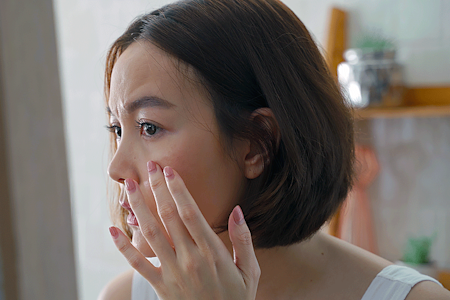Skin diseases and conditions in darker skin tones
How a skin disease or condition affects you can vary with your skin tone. Here you’ll get insight from dermatologists about some skin conditions that affect people with darker skin tones, either more frequently or more severely.

If you have thickening, darker skin on your armpits, neck, or groin, you may have this skin condition. It won’t harm you, but it can be a sign of a serious medical condition like diabetes.

If you have what feels like razor bumps or acne on the back of your neck or scalp, you may have acne keloidalis nuchae. Find out what can help.

Causing deep, painful lumps under the skin, HS can be mistaken for acne, an STD, or boils. Getting an accurate diagnosis and treatment from a dermatologist can prevent HS from worsening.

A keloid is a raised scar that grows larger than the wound that caused it. Find out what may stop this scar from growing larger, and possibly prevent it.

Lupus can affect the skin in many ways. Here you’ll see different types of rashes it can cause and find skin care tips that dermatologists give their patients who have lupus.

For people of African or Asian ethnicity, the feet and hands are the most common places to develop melanoma, the most serious skin cancer. Find out how to check your feet so that you can find melanoma early when it’s highly treatable.

While anyone can develop this skin cancer under a nail, it’s more common in people who have darker skin tones. This short video shows you what to look for.

Does your face often burn or sting? Do you have acne that just won’t go away no matter what you treat it with? Is your face frequently warm? You may have rosacea.

This disease causes growths called granulomas, which can develop on the skin, inside the body, or both. In the United States, Black women have the highest risk of developing sarcoidosis.

Seborrheic dermatitis is often described as a red rash. But on darker skin tones, the rash tends to be pink, purplish, or white. Knowing what to look for can help you find this rash early when treatment can prevent dark spots from developing.

People of all colors get skin cancer. This information can help you find skin cancer early when it’s highly treatable.

This condition causes the skin to lose its natural color and is more noticeable in darker skin tones. There is currently no cure, but treatment can help restore lost skin color.
 Atopic dermatitis: More FDA-approved treatments
Atopic dermatitis: More FDA-approved treatments
 Biosimilars: 14 FAQs
Biosimilars: 14 FAQs
 How to trim your nails
How to trim your nails
 Relieve uncontrollably itchy skin
Relieve uncontrollably itchy skin
 Fade dark spots
Fade dark spots
 Untreatable razor bumps or acne?
Untreatable razor bumps or acne?
 Tattoo removal
Tattoo removal
 Scar treatment
Scar treatment
 Free materials to help raise skin cancer awareness
Free materials to help raise skin cancer awareness
 Dermatologist-approved lesson plans, activities you can use
Dermatologist-approved lesson plans, activities you can use
 Find a Dermatologist
Find a Dermatologist
 What is a dermatologist?
What is a dermatologist?